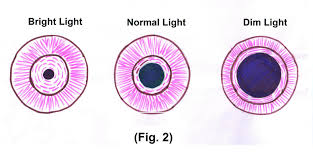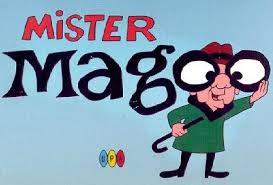The human eye is designed to see well in all levels of illumination. The pupil (the black opening in the center of the eye) expands when the surroundings are dim, to let in more light and make seeing easier. Then the pupil naturally contracts when you’re in a brighter area. So why do so many people have trouble with this simple process?
As with many other physical problems, our habits can get in the way of the natural functioning of the body. When the sun seems brighter than we like, we slap on sunglasses. (For more on light sensitivity, see this.) As soon as it gets a little darker late in the day, we turn on the lights in the house. We’re not giving our pupils a chance to respond to the different degrees of light! We might as well hope our legs get stronger, while we spend all day sitting, and drive everywhere that’s more than a block away.

Peter Grunwald, the developer of the Eyebody Method, once had a -10 level of myopia. He now teaches vision improvement all over the world, and does not need glasses to see better than 20/20. He told us when he started improving his own eyesight, he walked for hours after dark on his undeveloped property in New Zealand, learning to see everything he needed to see by moonlight and starlight. People who live close to the land have always done this. Several hundred years ago, we did not have street lights or flashlights.
Peter’s story inspired me, so when I came home from an intense 7-day workshop with him, I started walking on my neighborhood sidewalks after dark with no glasses. At first I felt daring and a bit afraid, but I soon came to look forward to it. Once a man almost walked into me in the dark. Obviously startled, he said “I don’t have my glasses on!” and apologized. I laughed to myself — his daylight vision was no doubt better than mine, as I needed -6 glasses back then to drive. And one of the best parts of those after-dark walks was how bright the inside of the house seemed when I went back home.
As I became less fearful of walking after dark, I could feel my entire being relax. I’m sure my eyes, as well as the rest of my body, were less tense and constricted, which naturally would help me see more clearly. One of the practices I do regularly now is to imagine my eyes and visual system opening up, expanding wider, letting in all the light and images to help me see as much as possible. If I visualize my pupils gently expanding when it’s dark, it feels like this helps me see more clearly, and be more connected to my surroundings.
To see better when the light is not bright, both your mind and your pupils need to be able to open up and let in what light there is, not fight it or shy away from it. Walking outside in bright sunlight, when your pupils will constrict, then entering an area of deep shadow where they’ll expand, is a wonderful simple way to get your visual system accustomed to different levels of light, with the caveat that you’re not straining. As with all vision work (really, play!), see how relaxed you can be while letting your eyes look around.

I have to add a few words about eyeglasses, which block the light to some degree, and the stronger the prescription, the more this is true. Think of someone very nearsighted taking off thick glasses and squinting — he or she is not used to such brightness! Wearing glasses is already a strain, as the eye has to adapt to look through the prescription. It’s like trying to run with braces on your legs, unnatural, so the body fights it. If you wear glasses, try to go without them occasionally to let yourself appreciate the light, especially out-of-doors.
To see better in all levels of light, reduce your visual strain as much as you can, especially your “I have to get it done now!” rushing straining attitude. Give your precious eyes the rest they need. And be grateful for all the vibrant visual treasure they deliver to you, every minute they’re open.
get help on our Facebook Group!

I wore strong glasses, then contact lenses, from age 5 into my 40s. While making many mistakes, eventually l learned how to improve the way I use my eyes and to see in a more relaxed, healthy manner. It is my pleasure to coach others to do the same. Visit me at https://NancyLNeff.com.

Thanks for reading, Barbara. And thanks for seeing my posts as gentle encouragement rather than nagging!
As always, Nancy, thanks for the motivation to nurture my eyes. I can’t hear/read it enough from you! My eyes thank you. xoxo
xoxo
I saw some workshop listed years ago for a “night walk” that an NVI teacher was doing. At the time I wasn’t sure what to think of it, but now I think it’s a great idea. It stimulates peripheral vision and gives a really low intensity visual environment that actually makes it easier to practice some things, even if at first the idea of walking around nearly blind is daunting.
Meir Schneider recommends as a one exercise for short sighted people… To walk at night.
It is said to improve eyeisight.
8888 (and David) I didn’t mention this in the post, but when I did 2 week-long workshops with Peter Grunwald, they each included a night walk over a mountain in a wooded setting. Back then I was frightened and felt like I couldn’t see anything at all. When I walk after dark here now, 10 or 12 years later, I feel much more relaxed and visually confident than I did back then.